
Minicourse Industrial Application
ICOPS 2023
Saturday & Sunday: May 21-22
of Plasmas
Chair: Dr. Evgenya Ivanovna Simakov
(Los Alamos National Laboratory)
Please click this sentence to view the minicourse schedule
as a printable PDF File.
Katharina Stapelmann
North Carolina State University
“A brief introduction to Plasma Medicine – Key roles of reactive oxygen and nitrogen species”
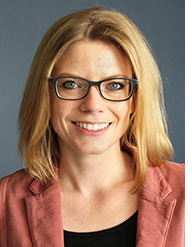 Prof. Katharina Stapelmann is an assistant professor of nuclear engineering at North Carolina State University. She received her Ph.D. in electrical engineering from Ruhr University Bochum, Germany, in 2013, where she continued as PostDoc (2014) and assistant professor of electrical engineering (2015-2017) before she joined NC State in 2017. Stapelmann’s research interests lie in the experimental investigation of generation and transport of reactive species for life science applications, e.g. plasma medicine and plasma agriculture. Stapelmann is Mercator Fellow (DFG), member of the board of trustees of the German national center of plasma medicine, and serves on the International Advisory Board of the Journal Plasma Processes and Polymers. In 2022, she was awarded by the International Society of Plasma Medicine with the Early Career Award in Plasma Medicine.
Prof. Katharina Stapelmann is an assistant professor of nuclear engineering at North Carolina State University. She received her Ph.D. in electrical engineering from Ruhr University Bochum, Germany, in 2013, where she continued as PostDoc (2014) and assistant professor of electrical engineering (2015-2017) before she joined NC State in 2017. Stapelmann’s research interests lie in the experimental investigation of generation and transport of reactive species for life science applications, e.g. plasma medicine and plasma agriculture. Stapelmann is Mercator Fellow (DFG), member of the board of trustees of the German national center of plasma medicine, and serves on the International Advisory Board of the Journal Plasma Processes and Polymers. In 2022, she was awarded by the International Society of Plasma Medicine with the Early Career Award in Plasma Medicine.
In this lecture, we will explore different emerging areas of plasma medicine, and how the reactive species play a key role for the application of low-temperature plasmas in medicine. Low-temperature plasma discharges in or in contact with air produce a variety of reactive oxygen and nitrogen species (RONS). The reactive species produced by plasmas are the same molecules that the human body generates for signaling or antimicrobial effects. Plasma treatment of eukaryotic cells can thus cause a similar effect as an innate immune system oxidative burst and plasma at low doses can mimic an immune response to tissue damage, wounds or infection which could initiate a natural healing response. Utilizing plasma-generated RONS for plasma-aided wound healing or plasma oncology is therefore a promising alternative to conventional treatments and the effectiveness of plasma for wound healing and cancer treatment has been shown in vitro and in vivo. Yet, the mechanisms of action and the delivery of RONS to the target are currently still under investigation.
Sergey Baryshev
Michigan State University
“Enabling Scalable Production and Supply Chain of Diamond using Microwave Plasma”
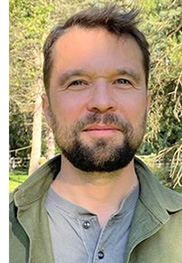
Prof. Sergey V. Baryshev received the B.S. degree in applied physics from Polytechnic University, Saint Petersburg, Russia, and the Ph.D. degree in condensed matter physics from the Ioffe Institute, Saint Petersburg, in 2008. He is currently a Faculty Member with the Department of Electrical and Computer Engineering, Michigan State University (MSU), East Lansing, MI, USA, where he also oversees education and workforce training in radio frequency (RF) power engineering for DOE-MSU Accelerator Science and Engineering Traineeship Program. He has worked extensively in accelerator research and development on creating solutions to enable novel electron emission sources and RF injector and linac designs that can outperform previous generations. This work was further extended to create novel solutions for field emission microscopy, ultrafast time-resolved microscopy, high peak power THz radiation generation, and to obtain new insights into the physics of vacuum breakdown. Particularly, his research interests also include the use of synthetic diamond for high power RF, microwave, and X-ray devices. To satisfy specific application requirements for diamond devices, he has started an active research program for finding new and optimal ways to produce high quality synthetic diamond feedstock materials at scale.
Like no other semiconductor, diamond is the ultimate engineering and frontier material of the 21st century. Diamond has the potential to reshape or revolutionize a wealth of industrial applications ranging from quantum computing to electric grid infrastructure. To realize the promise of diamond, we will need to be able to produce high quality, large size diamond plates at scale. However, despite decades of research, lab-grown diamonds are still limited in size and/or quantity. The majority of lab-grown diamond growth techniques nowadays utilize high-pressure, high-temperature (HPHT) growth processes that mimic the natural diamond formation with very slow growth rates. Producing large size diamond plates via HPHT is not practical, and at this point restricts the supply chain and scalability. Microwave plasma assisted chemical vapor deposition (MPACVD) has become one of the most popular methods for epitaxial growth of single crystal diamond and has the potential to overcome the supply chain issues. The temperature and pressure conditions in MPACVD reactors are far less extreme than in HPHT systems and are less prone to process breakdown. MPACVD diamond is typically grown at rates >10 μm/hr. Despite the existing benefits over HPHT, large area diamond epitaxy is much harder to achieve in MPACVD. In MPACVD, understanding of the interplay between the activated plasma and the substrate holder system is the key. The interplay in question is affected by macroscopic reactor parameters such as forward microwave power, total pressure, precursor gas flow rates, sample stage cooling and overall geometry of a MPACVD reactor. Because these macroscopic parameters are simply the means to actuate plasma and reactive species and heat flow, plasma modelling becomes critical for rapid growth optimization and comparison between various reactors. In this mini-course, self-consistent modelling specific to single crystal diamond growth will be presented with a specific goal to optimize plasma versus substrate domains for scalable growth. Namely, such modelling involves coupled 1) electromagnetic design of the reactor cavity, 2) plasma-microwave interaction, 3) plasma-substrate-cooling bath heat transfer, and 4) chemical kinetics and reactivity of the CH4/H2 plasma. Another part of the talk will focus on scalable high yield production of diamond nanoparticles using flow through reactors utilizing the same CH4/H2 plasma chemistry. This method is of significant interest as it allows for bottom up/additive device fabrication of photoelectrochemical, biomedical, electrooptical and cooling devices and systems. One other critical benefit is that such flow through reactors allow for nanodiamond deposition at the room temperature. Specific insights into in-flight diamond nanoparticle synthesis will be discussed. In all case studies considered, modelling and experiment will be compared.
George Osenga
Thierry Plasma Corporation
“Plasma Processing for Industrial Applications”
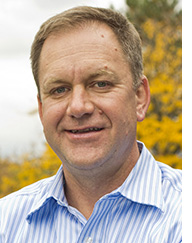 George Osenga is the Director of Operations for Thierry Plasma. He has worked in industry with atmospheric and low-pressure plasma more than 25 years. George Osenga applied plasma technology in the areas of cleaning, surface activation, etching, deposition, and coating. He is comfortable applying it to a variety of manufacturing industries including automotive, aerospace, sporting goods, medical, life sciences, paper, plastics, electrical, electro-optics, textiles, materials, marine, recreational vehicles, semiconductors, and disc-drives.
George Osenga is the Director of Operations for Thierry Plasma. He has worked in industry with atmospheric and low-pressure plasma more than 25 years. George Osenga applied plasma technology in the areas of cleaning, surface activation, etching, deposition, and coating. He is comfortable applying it to a variety of manufacturing industries including automotive, aerospace, sporting goods, medical, life sciences, paper, plastics, electrical, electro-optics, textiles, materials, marine, recreational vehicles, semiconductors, and disc-drives.
The purpose of this lecture and discussion is to highlight some of the key applications of plasma processing in industry today. Discussion of industrial examples of plasma processes for cleaning, activation, etching and deposition will include:
Atmospheric plasma systems for cleaning and activation of continuous flow manufacturing processes in production to include communication devices, computer displays, extrusions, medical devices, and automotive applications.
Plasma activation of polypropylene, thermoplastic polyurethane, thermoplastic polyolefin, and polytetrafluoroethylene in automotive and medical applications.
Plasma powder cleaning, treatment, and activation for incorporation and wetted dispersion in solution.
Plasma deposition of SiO2 and SiOx like coatings using hexamethyldisiloxane and other monomers as process precursors for automotive, microfluidic, and medical applications.
Artem Smirnov
TAE Technologies
“Aneutronic Fusion as a Driver for Technology Innovation”
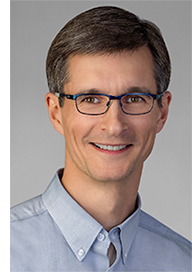 Dr. Artem Smirnov is a Chief Technology Officer at TAE Technologies, where he is leading a team of 250+ scientists and engineers pursuing disruptive R&D and technology commercialization projects in fusion energy, cancer therapy, data science, and more. He joined TAE Technologies as a scientist in 2006 and over the years contributed to the development of TAE’s accelerator technology, plasma confinement and stabilization techniques, plasma diagnostics, as well as commercialization of TAE technologies in adjacent markets. Dr. Smirnov holds several technology patents and has co-authored more than 50 peer-reviewed publications. He holds a Ph.D. in plasma physics from Princeton University and an M.B.A. from the UCLA Anderson School of Management.
Dr. Artem Smirnov is a Chief Technology Officer at TAE Technologies, where he is leading a team of 250+ scientists and engineers pursuing disruptive R&D and technology commercialization projects in fusion energy, cancer therapy, data science, and more. He joined TAE Technologies as a scientist in 2006 and over the years contributed to the development of TAE’s accelerator technology, plasma confinement and stabilization techniques, plasma diagnostics, as well as commercialization of TAE technologies in adjacent markets. Dr. Smirnov holds several technology patents and has co-authored more than 50 peer-reviewed publications. He holds a Ph.D. in plasma physics from Princeton University and an M.B.A. from the UCLA Anderson School of Management.
Abstract: TAE Technologies, Inc. (TAE) is a privately funded company pursuing a novel approach to magnetic confinement fusion, which relies on Field-Reversed Configuration (FRC) plasmas composed of mostly energetic and stable particles. This advanced FRC-based system simplifies the reactor design and could offer a path forward to clean, safe, and economical aneutronic p-B11 fusion.
To validate the science behind the FRC-based approach to fusion, an active experimental program is underway at TAE’s state-of-the-art plasma research facility in Orange County, California. The core of the facility is the world’s largest FRC device named Norman. In Norman, tangential injection of variable energy neutral beams (15 – 40 keV hydrogen, up to 20 MW total), coupled with plasma edge biasing, active plasma control, and advanced surface conditioning, led to production of steady-state, hot FRC plasmas dominated by fast ion pressure. High-performance, advanced beam-driven FRCs were produced, characterized by macroscopic stability, steady-state plasma sustainment, and dramatically reduced transport rates [1,2].
Our quest towards a practical FRC-based fusion reactor has stimulated innovation across a wide range of technologies. In particular, TAE has successfully developed and operated several state-of-the-art particle accelerator systems. Numerous breakthrough innovations in negative ion beams and high-energy accelerator technology, which were originally introduced to serve current and future fusion experiments, have been combined to create an advanced commercial accelerator for targeted cancer radiation therapy. Similarly, power management systems developed for Norman are finding commercial applications in electric vehicles, as well as in residential, industrial, and utility-scale electrical grid applications.
This lecture will cover the fundamentals of the FRC plasma confinement and aneutronic approach to fusion energy, and give a comprehensive overview of the TAE fusion research program, supporting technologies, and innovations in adjacent fields.
[References
[1] H. Gota et al., Nucl. Fusion 59, 112009 (2019)
[2] M. Binderbauer et al., Phys Plasmas 22, 056110 (2015)]
Nathan Cook
Radiasoft
“Design and modeling considerations for thermionic energy converters”
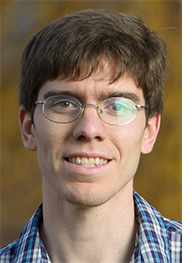 Nathan Cook is a Group Leader and Lead Project Scientist at RadiaSoft LLC in Boulder, CO, where he has been since 2015. Nathan's background is in computational accelerator physics, and he has a wide range of interests including advanced concepts accelerators, plasma systems, and beam diagnostics. His current work includes the design of data management and analysis frameworks for X-ray light sources, the study of beam collimators under high intensity beam interactions, and the modeling of thermionic energy converters. Nathan received his BA from Williams College and his PhD from Stony Brook University.
Nathan Cook is a Group Leader and Lead Project Scientist at RadiaSoft LLC in Boulder, CO, where he has been since 2015. Nathan's background is in computational accelerator physics, and he has a wide range of interests including advanced concepts accelerators, plasma systems, and beam diagnostics. His current work includes the design of data management and analysis frameworks for X-ray light sources, the study of beam collimators under high intensity beam interactions, and the modeling of thermionic energy converters. Nathan received his BA from Williams College and his PhD from Stony Brook University.
Abstract: Thermionic emitters are an essential technology across a wide range of applications, including particle accelerators, imaging, and energy generation. Thermionic energy converters are one such application, promising highly efficient heat-to-electricity transformation in a robust, scalable package, and providing unique opportunities for high density power generation in home, defense, and aerospace environments. Unfortunately, for practical devices, space charge from the emitted electrons can substantially limit the peak operating current, significantly limiting device performance, and continue to pose a challenge to their adoption. Plasmas, typically comprised of Cesium or other alkali vapors, may be employed to compensate for the resultant space charge, enabling these devices to overcome current density limitations and achieve higher power outputs. The design and optimization of these devices can require either comprehensive kinetic modeling, fluid modeling, or both to explore a large and coupled parametric space. We will provide an introduction to thermionic energy converters, present basic modeling techniques and formalisms for their study and evaluation, and discuss the role of plasmas in enhancing their operation in specific regimes. Though the specific applications will emphasize thermionic converters, the tools and techniques considered are widely applicable to other domains.
Max Light
Los Alamos National Laboratory
“Utility of Plasma Physics in Global Security”
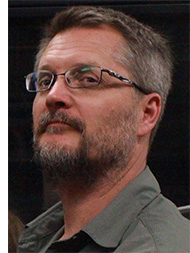 Dr. Max Light received his BSEE from the University of New Mexico (1989), and MSEE from UCLA (1994). He received a PhD from UCLA (2000) in Applied Plasma Physics studying instabilities in a helicon plasma. During that time, he worked at Los Alamos National Laboratory as a student from 1989 to 2000, joining as a scientist in 2000. His early work focused on plasma source design and development, and research into plasma characteristics for electric propulsion through a collaboration with NASA’s Johnson Space Center. He has also developed an electron beam plasma cathode electron cyclotron resonance source, worked extensively in plasma diagnostic design and implementation, electromagnetic wave propagation in plasmas, and electric propulsion research. Recently, his research is focused on electromagnetic wave propagation in the ionosphere, and the effects of ionospheric scintillation. From this, he created a complete source-to-sensor model to predict performance of the radio frequency electromagnetic pulse detection system currently used by the United States Nuclear Detonation Detection System (USNDS) program for treaty monitoring.
Dr. Max Light received his BSEE from the University of New Mexico (1989), and MSEE from UCLA (1994). He received a PhD from UCLA (2000) in Applied Plasma Physics studying instabilities in a helicon plasma. During that time, he worked at Los Alamos National Laboratory as a student from 1989 to 2000, joining as a scientist in 2000. His early work focused on plasma source design and development, and research into plasma characteristics for electric propulsion through a collaboration with NASA’s Johnson Space Center. He has also developed an electron beam plasma cathode electron cyclotron resonance source, worked extensively in plasma diagnostic design and implementation, electromagnetic wave propagation in plasmas, and electric propulsion research. Recently, his research is focused on electromagnetic wave propagation in the ionosphere, and the effects of ionospheric scintillation. From this, he created a complete source-to-sensor model to predict performance of the radio frequency electromagnetic pulse detection system currently used by the United States Nuclear Detonation Detection System (USNDS) program for treaty monitoring.
Abstract: LA-UR-22-31302
The United States Nuclear Detonation Detection System (USNDS) includes a constellation of satellite-based detectors that monitor different phenomena generated from a nuclear detonation on Earth, for treaty monitoring. One of these phenomena is the radio frequency (RF) signal driven by the electromagnetic pulse (EMP) generated from a nuclear detonation. This signal must propagate to the detector through the Earth’s ionosphere, where it will experience dispersion, refraction, and in some cases scintillation due to instabilities or irregular structure in the ionospheric plasma. Characterizing the signal’s properties can only be done by utilizing tools such as the theory of EM wave propagation in magnetized plasmas, plasma wave dispersion, and the statistics of stochastic plasma structure. These topics, and their utilization, will be covered in this lecture in the framework of characterizing on-orbit RF signal detection essential for the USNDS treaty monitoring mission.
John Foster
University of Michigan, Ann Arbor
“Plasma Based Water purification: Current Status, Methods and Challenges”
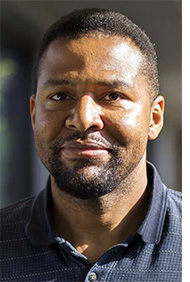 Prof. John Foster has worked in the field of low temperature plasmas for nearly 27 years dating back to his undergrad years. His research efforts have included plasma thrusters, plasma processing, and atmospheric pressure plasmas. He has been involved in plasma-based water purification and atmospheric pressure plasma research for nearly 15 years. This work has resulted in numerous publications and conference presentations. His research in the area of plasma-water interactions has in recent times focused on the problem of scaleup and that of plasma self-organization. His group at University of Michigan is currently developing a patented plasmas reactor concept for once-through water treatment. A key goal of his atmospheric pressure plasma efforts is to contribute to the penetration of plasma-based water treatment technologies into the water treatment market to address new and emerging threats to fresh water security as well as address the National Academies Grand Challenge of clean water for all.
Prof. John Foster has worked in the field of low temperature plasmas for nearly 27 years dating back to his undergrad years. His research efforts have included plasma thrusters, plasma processing, and atmospheric pressure plasmas. He has been involved in plasma-based water purification and atmospheric pressure plasma research for nearly 15 years. This work has resulted in numerous publications and conference presentations. His research in the area of plasma-water interactions has in recent times focused on the problem of scaleup and that of plasma self-organization. His group at University of Michigan is currently developing a patented plasmas reactor concept for once-through water treatment. A key goal of his atmospheric pressure plasma efforts is to contribute to the penetration of plasma-based water treatment technologies into the water treatment market to address new and emerging threats to fresh water security as well as address the National Academies Grand Challenge of clean water for all.
Abstract: Plasma-based water purification has the potential to revolutionize the way we process wastewater. It is essentially non-selective and thus can be brought to bear on a wide range of contaminants including those conventionally recalcitrant like PFAS. Plasmas provide the energy, particles and fields that ultimately drive gas and liquid phase nonequilibrium chemistry such as advanced oxidation and reduction ultimately leading to mineralization of contaminants. In this class we review methods of placing plasma in contact with liquid water and approaches to implementing such methods in an actual water processing reactor. Furthermore, we discuss metrics used to assess the efficiency of plasma-based water reactors and challenges to characterizing parameters such as deposited power and delivered dose. Batch and once-through plasma reactor approaches are also discussed in the context of embodiments for real world applications. Parallels are made with conventional chemical reactor systems. Challenges to scaleup are reviewed along with solutions aimed at achieving large-scale water treatment. We also discuss the framework of what would be required for technoeconomic analysis of large-scale plasma reactor implementation. Finally, we review specific reactors and their performance on a range of chemicals including pilot scale systems---as well as highlighting current commercialization activity. We conclude with a discussion of current research questions, research opportunities, and prospects for the future.
